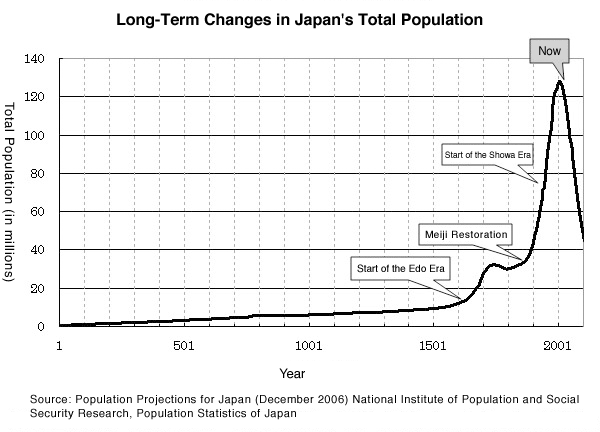Top>Opinion>Time Is Running out for Japan's Dwindling Population
 Index
Index

Kohei Wada [Profile]
Time Is Running out for Japan's Dwindling Population
Kohei Wada
Professor of Demographic Analysis and Applied Demography, Faculty of Economics, Chuo University
The Arrival of a Shrinking Society
The other day, the preliminary figures of the National Census were released. With the situation unchanged and no sign of a return to the increase experienced in the past, the figures indicate an overwhelming trend towards a decline in population ahead of us. The words low birthrate and aging population or population decrease are often used in recent years, but what kind of image do people have about the future of Japan's population? The following diagram shows the population of our country from A.D. 1 to 2105. The estimated values between 2005 and 2105 are based on the population projections of the National Institute of Population and Social Security Research. The forecast predicted that the population, which increased rapidly during the years of spectacular economic growth, would suffer a sudden, sharp decline from the start of the new century-a drop we are faced with right now.

Japan's Population and the Danger of Extinction
On the assumption that the time for one generation, which the field of demography refers to as the mean length of generation, is 30.17 years (using the 2005 figures), the time span of three generations equates to 90.51 years. If we take the Population Census figure which shows the total population of 127,767,994 for the year 2005 and apply the above-mentioned population projection, we get an estimated total population of 50,449,303 for the year 2096. This figure represents a decrease of some 60.5%. To answer why this kind of calculation was carried out, if we look at the population decrease, it is equivalent to the endangered species Category IB by the Red Data Book of the Ministry of Environment, whose familiar example includes common seals, Hodgson's hawk eagles and Loggerhead sea turtles, species which have a high danger of extinction in the near future, and whose prerequisite is that we see that over the next ten years, or three generations (whichever is longer), we find a decrease of around 50% or more. Moreover, while there are question marks over how reliable the predictions might be, if we assume that the fertility and mortality rates are unchanged and there is no further international maigration, then according to this estimation the population would dip below 1000 people by A.D. 3000. Granted that you might consider it somewhat heavy-handed to draw comparisons between a race of people and another species and make projections (using assumed values) some 1000 years into the future, I would hope that you now feel more concerned by the decline facing this country's population, which is decreasing at the fastest rate of all the world's nations, than you did before.
Predictions Stretching Back at Least 30 Years
Changes in population can be predicted with far greater accuracy than for stock price or currency movements. This is particularly the case for long term forecasts. While it is, by definition, hard to pinpoint exactly when the population decrease will start, it is clear that the turning point has been reached. In fact, there were signs of a decrease in population as early as the mid-1970s. There is a standard known as the population replacement level. If the level of the birthrate, which is called the total fertility rate, is above this replacement level, the population will continue to show a long-term increase, but if the rate is below the replacement level, there will be a decrease. Japan dipped below this level, which is set at around 2.07, in 1974 (when it reached 2.05) and has fallen further since then. It is thought that this is where the so-called low birthrate started. Needless to say, this does not equate to an immediate decrease in the overall population. In a kind of delayed reaction, movements in the overall population are only evident after about 30 years; the passage of the mean length of generation. Conversely, even if the fertility rate were to immediately recover to reach the population replacement level, we would have to wait 30 years before seeing an increase in population. Measures to counter the low birthrate are desirable, but the fact that the effects will not be evident for decades means that there is a tendency to give a low priority to such policies. Since the nation's finances are severe, it is hard to decide whether to use money to improve the birthrate to help the generations to come-our children and grandchildren-or to devote such money to measures designed to combat the current serious recession. That said, if measures to recover the birthrate are not started right now, our country faces grave problems in the future.
In Pursuit of a Higher Birthrate
Clearly, in order to stave off a decrease in population, we have to raise the birthrate. In other words, we need to overcome the present decline. Let's consider examples from some other countries. In the case of France, a country which is often referred to, the nation has for many years implemented a family policy to raise the birthrate. France has a system of taxation which is advantageous to large families, granting a sizeable family allowance, with no income limitation, upon the second or higher child as well as subsidies for babysitters. Moreover, Scandinavian countries are maintaining a high birthrate by providing an environment where women can raise children while they work. In the United States and Australia, governments have increased their overall population by accepting large numbers of immigrants, who have also taken a positive attitude towards raising children there. So what should our nation be doing? Although the child allowance has attracted a lot of attention in recent years, from a financial point of view, we are not able to provide a great deal of support and the work-life balance and situation in the workplace seem difficult in the midst of this economic recession. Furthermore, isn't it considered taboo to even discuss the further acceptance of immigrants? As a means to raise the birthrate, from the unique viewpoint of our country and East Asia, I would like to recommend strengthening the influence of relatives and local communities. When Okinawa, the prefecture with the highest fertility rate, was investigated, a spirit of mutual support known as yuimaru came to the fore. Moreover, the three towns in Tokunoshima (Kagoshima prefecture) ranked 3rd in the fertility rate figures for Japan's municipalities (2003-07 annual average), are home to the saying kuwadou takara (children are treasures); a phrase which encompasses the view that children are property belonging to everyone and should be brought up by the community. Despite the fact that children bring profit to the whole country when they become adults, the burden of rearing them is placed exclusively on young parents acting individually. Yet it could be argued that we need to engender the spirit involving relatives and the whole community being more actively involved with raising the children. In other words, there is a need to move the base for rearing children from the individual to the community.
- Kohei Wada
Professor of Demographic Analysis and Applied Demography, Faculty of Economics, Chuo University - Born in Miyagi in 1969, Kohei Wada graduated from the Faculty of Commerce at Chuo University in 1991. He completed the first semester of his doctoral degree at the institution's Graduate School of Economics in 1993. Having quit in the second semester of his doctorate there in 1997, he served as a research assistant and assistant professor at Faculty of Economics, Chuo University before taking up his current position in 2006. He was a visiting fellow at the Australian Demographic and Social Research Institute of the Australian National University from 2008 to 2010. He was commissioned to serve in the Cabinet Office (where he was responsible for addressing the declining birthrate problem) and was a member of the population task research group within the Ministry of Finance. He has also served as a member of the Scientific Panel on the Impacts of Population Ageing, which is part of the International Union for the Scientific Study of Population.
- His current research involves population and household projections, together with regional economic analysis by demography and the application of marketing.
- Major works include Learning Demography with Excel [Excel De Manabu Jinko Tokeigaku] (Ohmsha, 2006), for which he received both an incentive award for progress from the Population Association of Japan and an academic research award from Chuo University. He has also collaborated on a number of works such as The Future of Population Decline and Below-Replacement Fertility Society [Jinko Gensho/Shoshika Shakai No Mirai] (Akashi Shoten, 2007), Japanese Economy in the era of Population Decline [Jinko Gensho Jidai No Nihon Keizai] (Harashobo, 2006) and Low Fertility and the Japanese Economy [Shoshika To Nihon Keizai] (Nihonhyoronsha, 2006)
- Research Activities as a Member of Research Fellowship for Young Scientists (DC1), Japan Society for the Promotion of Science (JSPS) Shuma Tsurumi
- Important Factors for Innovation in Payment Services Nobuhiko Sugiura
- Beyond the Concepts of Fellow Citizens and Foreigners— To Achieve SDGs Goal 10 “Reduce Inequality Within and Among Countries” Rika Lee
- Diary of Struggles in Cambodia Fumie Fukuoka
- How Can We Measure Learning Ability?
—Analysis of a Competency Self-Assessment Questionnaire— Yu Saito / Yoko Neha - The Making of the Movie Kirakira Megane








